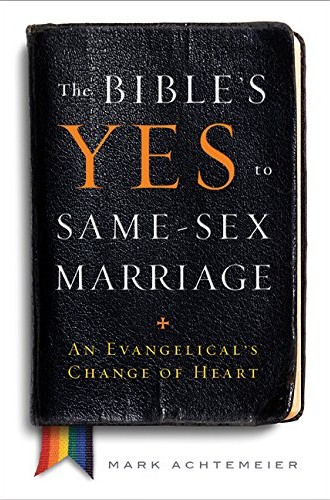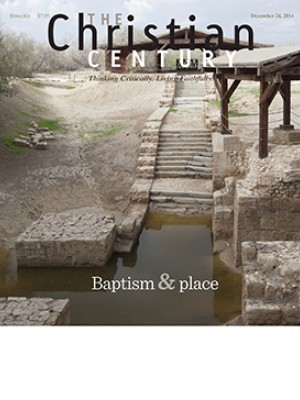The Bible’s Yes to Same-Sex Marriage, by Mark Achtemeier
I first met Mark Achtemeier in one of the committee rooms at a Presbyterian Church (U.S.A.) General Assembly in the mid-1990s. We were on opposite sides of a perennial issue for Presbyterians: whether the church’s ban on gay ordination should be codified in the denomination’s constitution.
At that point Achtemeier had become one of the most vigorous and articulate spokespersons for the conservative cause in Presbyterian circles, a frequent keynote speaker at national church gatherings of Presbyterians for Renewal and other evangelical groups, and one of the chief defenders of church orthodoxy on matters of sexual purity.
Read our latest issue or browse back issues.
After leaving the Presbyterian ministry because I had been outed as a gay man in 1990 by two members of the congregation I served, I soon became an advocate for change in the denomination. At the time I met Achtemeier, I was national co-moderator of the More Light Presbyterians.
When we exchanged pleasantries in the heat of legislative battle at that General Assembly, neither of us could have imagined that 16 years later Achtemeier would be preaching at my ordination as the first openly gay, partnered candidate for the Presbyterian ministry under a new church policy Achtemeier helped create. Nor could we have dreamed that he would become one of the leading spokespersons in the denomination favoring church blessing of same-sex marriage.
How did this remarkable conversion happen? The Bible’s Yes to Same-Sex Marriage: An Evangelical’s Change of Heart is Achtemeier’s account of the journey. Part memoir and part theological treatise, Achtemeier’s spiritual travelogue chronicles each step along his path with grace, humility, and pastoral sensitivity. Written as a first-person narrative, it unpacks complex theological topics in an accessible, nontechnical way. Conservative Christian lay readers struggling to understand LGBT sexuality and marriage are clearly his target audience.
Books by evangelicals about same-sex relationships typically begin with the so-called clobber texts—the seven passages of scripture that mention same-sex behavior—then build a hermeneutical and theological framework around these texts that lead conservative authors to support traditional church teaching and its practical application, namely celibacy, in the lives of LGBT believers.
Achtemeier moves in the opposite direction. He begins with his experience of gay and lesbian Christians: friends, acquaintances, and students at Dubuque Seminary, where he taught theology for 15 years. He found the practical application of traditional church teaching leading his LGBT circle of companions into despair, self-hatred, and anger at God, which didn’t square with what he contends are the fruits of the Christian life. This cognitive dissonance sent Achtemeier back to the Bible with a set of foundational theological questions that had largely been missing from church debates on sexuality.
Using five Reformed principles of biblical interpretation, Achtemeier avoids the trap of proof-texting individual passages and instead begins his hermeneutical journey by looking for a coherent message in the full sweep of the biblical story, the big picture of the nature of God.
One of the most interesting aspects of Achtemeier’s interpretive frame is his focus on the intent of scriptural teaching. Drawing from Calvin’s exposition of the Ten Commandments in the Institutes of the Christian Religion, Achtemeier conveys his understanding of the purposes of God that stand behind biblical law:
What are the highest purposes that emerge in the Bible for love, sex and marriage? Why did God invent these gifts and make them a part of human life? What was God trying to accomplish in creating human beings with the capacity of entering into these experiences? What purposes did God have in mind for our use and enjoyment of these gifts?
Achtemeier then constructs a thoroughly traditional theology of Christian marriage from his Reformed perspective, identifying throughout the biblical witness God’s self-giving love as the basis for Christian marriage. The purpose of marriage, Achtemeier concludes, “is to grow into a deeper and richer experience of the joy, passion and fulfillment that come with giving ourselves wholly to one another in accordance with the pattern of Christ’s self-giving love.”
Can this understanding of Christian marriage apply to same-gender relationships? Achtemeier answers affirmatively. But what about procreation? Achtemeier finds no biblical warrant for excluding childless couples; instead, he highlights the biblical understanding of believers as adopted children of God to support gay couples as adoptive parents. Male and female anatomy? Although Achtemeier affirms gender complementarity as the normative pattern for Christian marriage, he cites numerous biblical examples in which God delights in confounding standard expectations and conferring blessing outside the conventional, majority ways of doing things—most notably in the birth of Jesus and the conversion of the gentiles.
In the concluding chapters of the book, Achtemeier applies his theology of marriage to the clobber texts, seeking to understand each one in the context of the larger biblical witness. Then, in his chapter “Testing the Spirits,” he dismantles the slippery-slope arguments raised in conservative rhetoric, debunking the idea that same-sex marriage will lead us down the path of support for extramarital relations, polygamy, incest, or sexual relations with children.
The strength of this book may also be its greatest weakness. In making his theological framework for marriage accessible to a general Protestant audience, he may be limiting its appeal. Achtemeier misses a fuller treatment of the variety of ways scripture views marriage, for example, and he does not fully unpack the role of natural law in Roman Catholicism, which has implicitly shaped church teaching on marriage for centuries. I also doubt that many evangelicals outside the mainline traditions will look favorably on Achtemeier’s interpretive worldview. However, the insightfulness of his biblically grounded approach should spark deeper reflection on the conventional Christian wisdom about marriage among thoughtful conservatives.
If you’re looking for an introductory text that takes a high view of scripture and argues for the appropriateness of Christian marriage for same-gender couples, Achtemeier’s is the book I heartily recommend. Its clarity, disarming simplicity, and gracious tone will make it a welcome book not only for the pastor’s library and adult study classes, but for LGBT believers and their families who feel estranged from the church.







